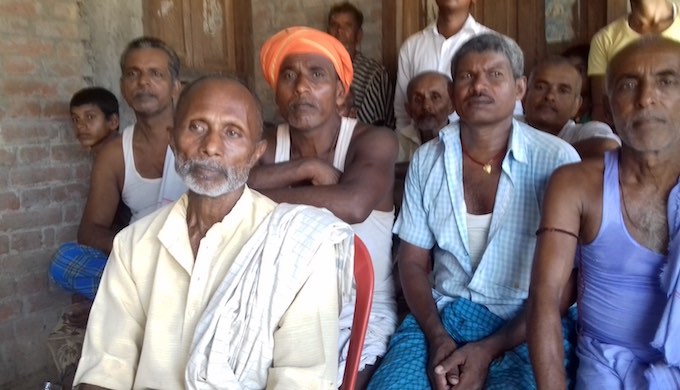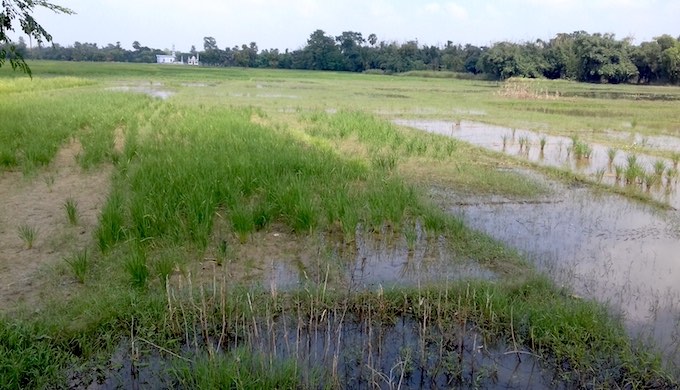The success of index-based flood insurance in three villages of northern Bihar as a pilot project has ensured that it will be expanded to 15 districts of the state next year

Farmers in Muzaffarpur district of northern Bihar at a meeting to discuss index-based flood insurance (Photo by Mohd Imran Khan)
Bhubaneswar Shani and Mahender Rai, both small farmers, are not worried despite the flood damage to their paddy crop this year because they will get index-based flood insurance. They are two of 200 farmers in six villages of flood-prone Muzaffarpur district in northern Bihar who opted for flood insurance designed to increase the resilience of communities at increasing risk of floods due to climate change.
Sahni, in his late 60s, and Rai, in his late 50s, are residents of Madhurpatti village in Gaighat administrative block. They are smallholders who own less than an acre of land and have been enrolled for the insurance cover free of cost. “Unlike big and rich farmers, smallholders like us will get compensation of crop damage due to floods thanks to the high-tech insurance,” Rai told indiaclimatedialogue.net.
It is now clear that climate change is adding to the magnitude of flooding during the monsoon and causing extensive crop damage in large parts of India, putting at risk the livelihoods of millions of farmers. What worries experts as well as farmers is that the 2017 rainy season was more severe than usual. It caused the deaths of nearly 1,000 people and triggered floods and landslides in Bangladesh, India and Nepal.
Climate hazards
Climate hazards are not new to farmers in South Asia, particularly in India. About 750 million people in South Asia were affected by such risks between 2000 and 2010. Millions of farmers in flood-prone areas in India are more vulnerable than any other place since there are no risk-mitigation measures available to them.
Although flood-affected farmers were assured of help that include compensation and insurance by successive governments, reality on the ground shows that they never get adequate money for their losses. They keep blaming the government’s apathy for it. “Last time we got compensation money for crop damage was in 2010,” Shani told indiaclimatedialogue.net.
Shivchand Rai and Ram Badhan Rai, both smallholder farmers in Madhurpatti village, are confident of getting insurance for their damaged paddy crop, unlike in the past. This has been made possible by an initiative by International Water Management Institute (IWMI).
“I was insured for crop damage due to flood free of cost this year for the first time in my life,” said Shivchand, who owns 7.5 acres of farmland. Even a rich farmer like Bisambhar Prasad Yadav of Belaur village is looking forward to get benefit of the index-based flood insurance (IBFI).
This scheme is likely to be especially beneficial for smallholders, who are particularly vulnerable to crop damage from extreme weather events. “Climate change threatens to unleash more frequent floods. Satellite-verified flood insurance can underpin smallholder farmers’ livelihoods, as well as helping nations meet global development goals,” Giriraj Amarnath, research group leader of IWMI, told indiaclimatedialogue.net.
Climate change magnifies the risk of disasters and increases their costs. As the climate system has warmed, the number of weather-related hazards globally has tripled, and the number living in flood-prone areas and cyclone-exposed coastlines has doubled. This trend is expected to increase, according to Amarnath.
Vulnerable agrarian belt
In South Asia, many of the region’s vulnerable people live in the vast agrarian belts along the Indus and the Ganga-Brahmaputra-Meghna basins, which are subject to widespread seasonal flooding. Monsoon variability, the La Niña phenomenon in the Pacific Ocean, the Indian Ocean dipole and other factors often result in large-scale flooding, which has significant impacts, especially on the poor and vulnerable populations who depend on subsistence agriculture.
“IBFI can be a good instrument to provide support to farmers in flood-prone areas,” K.M. Singh of Dr Rajendra Prasad Central Agriculture University at Pusa in Samastipur district told indiaclimatedialogue.net. “It can be a key contribution to climate change adaptation if the cover is based on information that include satellite and historical data.”
Singh said IBFI is in the initial stage now, pilots are still being conducted, but it is a move in the right direction that has the potential to increase resilience of farmers. Some of India’s most vulnerable states are also home to its poorest farmers. In Bihar, which loses between USD 0.5-120 million to floods every year, 78% of the population earn less than USD 2 per day.

Flooded farmland with standing paddy crop in Muzaffarpur district of Bihar (Photo by Mohd Imran Khan)
In India, floods affect some 30 million smallholder farmers every year. The centra; government is currently subsidising the largest crop insurance scheme in the world — Pradhan Mantri Fasal Bima Yojana (Prime Minister’s Crop Insurance Scheme) — which aims to cover more than half of all farmers in the country within the next two or three years.
Raising resilience
The flood insurance product will generate flood characteristics across selected pilot districts throughout the monsoon and will notify the insurance company, bank and farmers via SMS when the pre-determined threshold of flood depth or duration is breached. The insurance company will give payouts accordingly, crediting money directly to each eligible farmer’s bank account. The farmer receives another SMS indicating settlement of insurance claim.
Following the publication of the fifteenth Global Assessment Report (GAR15) by the United Nations Office for Disaster Risk Reduction (UNISDR), the Sendai Framework for Disaster Risk Reduction 2015-2030 was adopted in March 2015. Its seven targets include reduction of direct disaster economic loss in relation to global Gross Domestic Product (GDP) by 2030.
One of its four priorities states: “Public and private investment in disaster risk prevention and reduction through structural and non-structural measures are essential to enhance the economic, social, health and cultural resilience of persons, communities, countries and their assets, as well as the environment.” Using insurance to build in resilience within agriculture in developing economies has the potential to help nations meet their Sendai targets and the wider Sustainable Development Goals (SDGs).
Climate safety net
According to IWMI scientists involved in the IBFI pilot project in Bihar, it makes sense to have disaster-mitigation measures in place before and not after the floods to enhance resilience of farmers. “It is simple. The government should invest in disaster before it strikes through paying premium for disaster risk financing,” one of the scientists said. “It will be a part of the climate safety net.”
The farmers in the pilot project have insured crops for a total of around INR 5 million (USD 80,000). The villages were selected based on the flood damage they have suffered in the past. They have suffered agricultural losses with an estimated value of USD 3,340 million in the past 12 years. Annually about 73% of Bihar is flooded and nearly 76% of the population is at risk of flooding, IWMI estimates. Muzaffarpur district alone has incurred losses of over USD 3 million per year from 2001 to 2012 due to floods.
IWMI developed IBFI for Bihar in collaboration with global reinsurer Swiss Re. The institute’s scientists examined past satellite images to identify historic floods and prepare a flood-risk map. Villages in three locations were selected for the pilot — one in an area at high risk of flooding, one in medium risk and one with a low risk of inundation. A hydrological model was developed using 35 years of observed rainfall and discharge data from gauges. When contemporary rainfall data is added, the model is able to make predictions of where the water will run off and collect. In other words, it can indicate where flooding is likely to occur.
IWMI used latest remote sensing data, Geographical Information System (GIS) technology and computer modelling for IBFI. The approach, known as AgRISE (Agricultural Remote Sensing Insurance for Security and Equity), seeks to provide all farmers, no matter how small their holding, with the security that insurance can provide.
IWMI’s researchers said IBFI is a viable solution to increase resilience of farmers. “The combination of satellite technology and historical data will enable insurers to offer smallholders affordable insurance that helps to increase their resilience to climate change impacts,” they said.
After the successful experiment in Muzaffarpur, IWMI with funding from the CGIAR’s Climate Change, Agriculture and Food Security (CCAFS) and Water, Land and Ecosystems (WLE) is set to insure thousands of farmers for IBFI in 15 districts of Bihar next year.
“This model of insurance should be adopted to help farmers in flood-prone Bihar and other states,” Gopalji Trivedi, agriculture scientist and former vice-chancellor of the agricultural university at Pusa, told indiaclimatedialogue.net. “The IBFI model is a timely one to cover the risk of extreme weather events.”

Trackbacks/Pingbacks